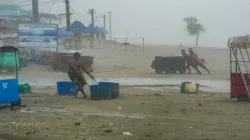Cyclone Remal makes landfall | Know what the name means and how it is given
Remal made landfall between Sagar Island in West Bengal and Khepupara in Bangladesh on Sunday night. The wind speeds clocked up to 135 km per hour.

Cyclone Remal: Cyclone Remal made a landfall in the early hours of Monday between Sagar Island in West Bengal and Khepupara in Bangladesh. The name "Remal", meaning 'sand' in Arabic, was chosen by Oman according to the standard convention of naming tropical cyclones in the region. This practice raises the question of why Oman, located on the Arabian Sea, can name a cyclone in the Bay of Bengal and why cyclones are named at all.
The World Meteorological Organization (WMO), a United Nations agency with 185 members, and the Economic and Social Commission for Asia and the Pacific (ESCAP), a regional commission under the UN Economic and Social Council, collaborated to boost economic activity in Asia and the Far East. To enhance cyclone warning and disaster mitigation in the North Indian Ocean region, the WMO established the Panel on Tropical Cyclones (PTC) in 1972. Initially, the PTC included eight countries: Bangladesh, India, Maldives, Myanmar, Pakistan, Sri Lanka, Oman, and Thailand. During its 2000 session in Muscat, Oman, the PTC decided to start naming tropical cyclones in the Bay of Bengal and the Arabian Sea. After gathering recommendations from each member, the PTC finalised the list and began naming cyclones in 2004.
In 2018, the PTC expanded to include Iran, Qatar, Saudi Arabia, the United Arab Emirates, and Yemen. In April 2020, a new list of 169 cyclone names—13 from each of the 13 countries—was released. This list is currently used to name cyclones in the region.
How are the cyclones named?
The countries sending their proposals need to follow some basic guidelines, which include ensuring that the propose name
- Is neutral regarding (a) politics and political figures, (b) religious beliefs, (c) cultures, and (d) gender.
- Does not offend any population group worldwide.
- Is not excessively rude or cruel.
- Is short, easy to pronounce, and not offensive to any PTC member.
- Is a maximum of eight letters long.
- Comes with its pronunciation and a voice recording.
- Is unique (not used before or after).
The list of proposed names arranges the countries in alphabetical order and includes all the names they suggested. These names are then assigned to cyclones in the region on a rotational basis, regardless of which country proposed them.
Why give cyclones names in the first place?
Well, it's all about simplicity and clarity. Unlike using numbers or technical terms, names are easier for everyone to remember—from the general public to scientists, media, and disaster managers. Having a name for each cyclone facilitates quick identification, raises awareness of its development, enables rapid warning dissemination to boost community readiness, and avoids confusion when multiple cyclones affect a region. Similar naming conventions exist for tropical storms in other parts of the world.
ALSO READ | Cyclone Remal makes landfall in coastal West Bengal; heavy rains, gusty winds lash Kolkata | 10 Points
ALSO READ | Cyclone Remal makes landfall: Trees uprooted, waterlogging, flights yet to resume | See pics